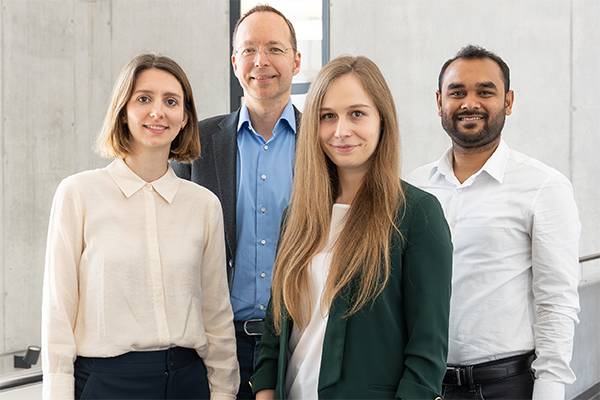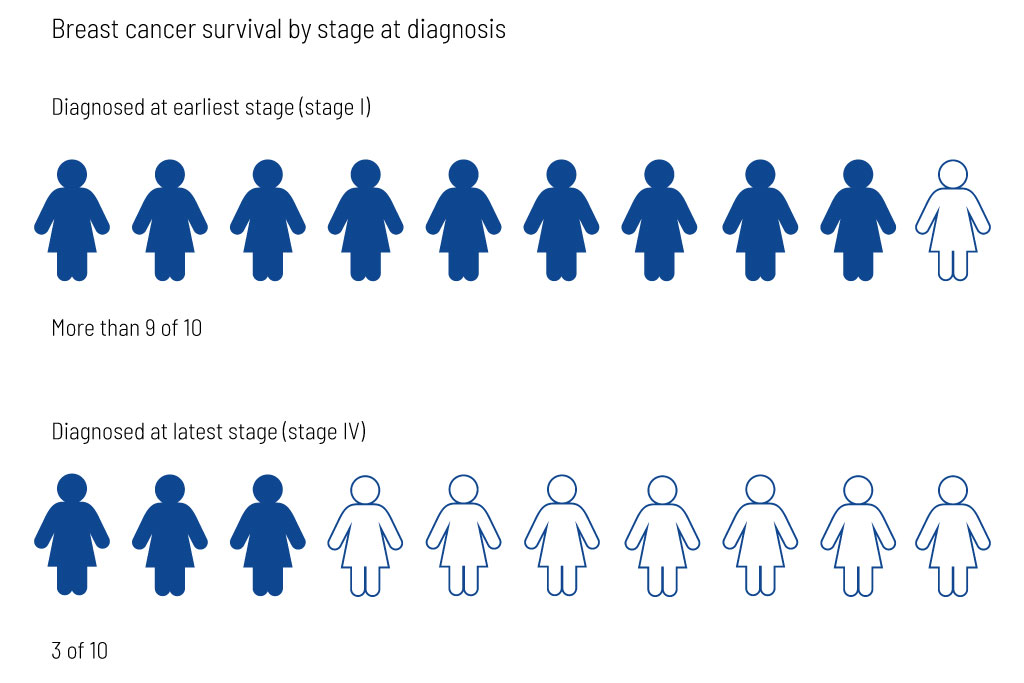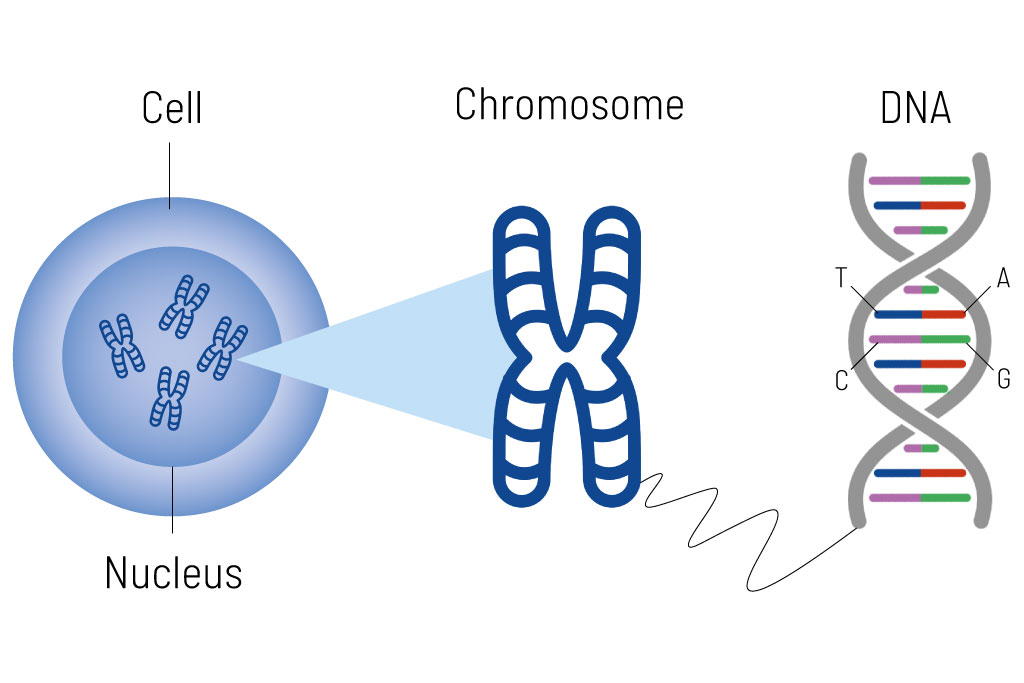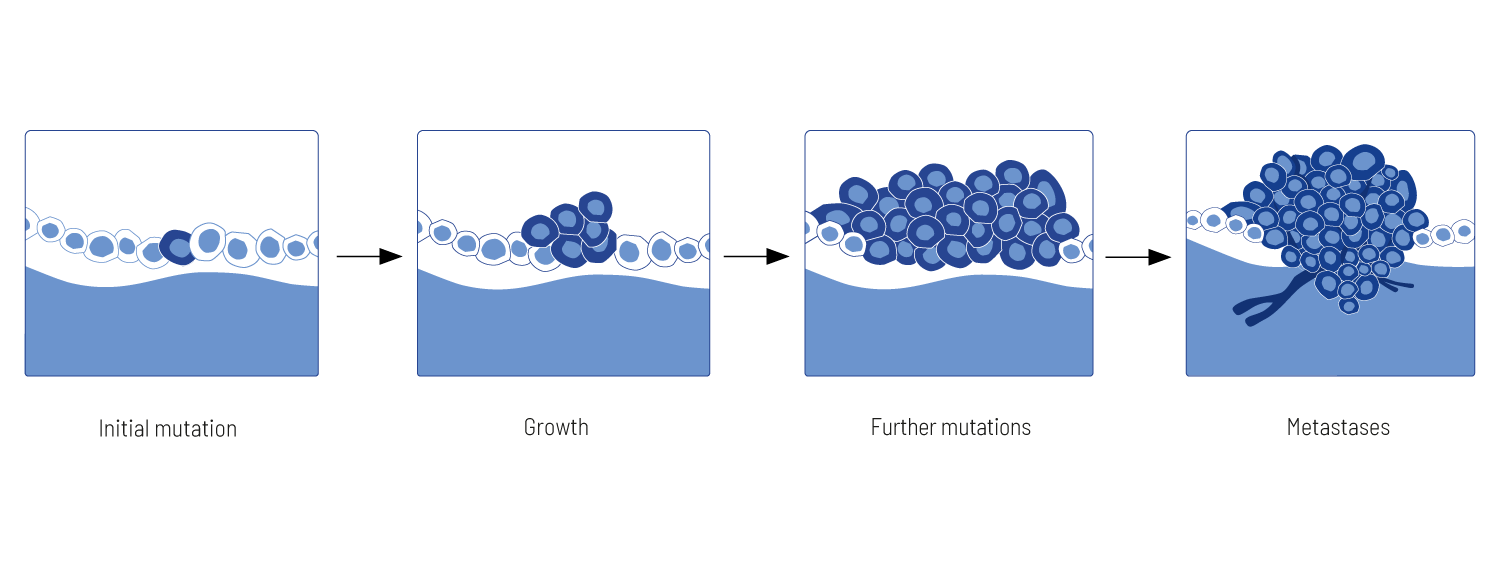Tumor diseases can be caused by inherited changes in the genetic information. With an individual preventive healthcare plan, potential tumors can be detected early and treated more effectively.
Early detection can significantly improve prognosis: More than nine of ten women that develop breast cancer survive five years or longer, if the disease is diagnosed at an early stage (stage I). This number decreases to three out of ten women if the breast cancer is diagnosed at a late stadium (stage IV) (figure 1).
Are you insured in Germany? Our colleagues at the Zentrum für Humangenetik Tübingen will gladly support you!
Figure 1: 5-year survival rate with breast cancer by stage at diagnosis (data from1).
What Are Tumor Diseases?
A tumor is a formation of new cells (neoplasia). If these newly built cells are malignant, they are referred to as cancer. Such tumors are characterized by uncontrollable cell growth. Over time, they destroy the surrounding tissue and form metastases.
Figure 2: Almost every cell in the body has a nucleus in which the chromosomes are located. Each chromosome is made up of DNA tightly coiled many times around proteins called histones that support its structure (chromatin thread). DNA consists of the basic building blocks A, C, G, and T. Each gene consists of a specific sequence of these building blocks. There are several hundred to several thousand genes on a chromosome.
Disease-causing changes in the genetic material of individual cells play a decisive role in the development of cancer. In many cases, external factors (e.g., exposure to radiation or smoking) are considered to trigger these changes. Part of the occurring tumor diseases arise due to inherited changes in the genetic information though.
The genetic information is called DNA and consists of four basic building blocks: adenine (A), guanine (G), cytosine (C) and thymine (T). The order of these building blocks determines the blueprint of our cells. A specific section on the DNA that carries the information for building a specific protein is called a gene. Many genes taken together make up a chromosome (figure 2).
If there is a change (variant) in the genetic information, this can lead to malformation of the protein. If this protein is involved in cell growth or cell division, a tumor can develop (figure 3).
Tumors in the early stages are often easier to treat. Early detection of the disease (and the predisposition) is therefore important.
Figure 3: Cancer cells (dark blue) can develop due to a change in the DNA sequence (gene variant) and subsequently grow uncontrollably and form a tumor. If tumor cells spread to other tissues, so-called metastases arise.
Field Report
Malika S., 26 years old
Lifestyle: enjoys cooking, spends a lot of time with her family
Result: Our preventive diagnostics revealed an increased risk of tumors in Malika S. due to a variant in the PMS2 gene, which can cause tumors in the intestines, uterus and other organs.
Consequence: Malika S. now regularly attends close-meshed cancer screening examinations, as the chances of recovery are much better with early detection and treatment than if a tumor is discovered late. This includes, for example, colonoscopies and other screening examinations.
“Cancer prevention is an important topic in my environment. That’s why I had myself tested and know that I should have regular examinations for early detection. That way, I have better treatment options if I do develop a cancer.”

How Does Genetic Risk Assessment Work?
Many factors can contribute to the development of tumors, such as UV light, certain diets, smoking, alcohol, and genetic predispositions. We help to determine the genetic risk. To do this, we use next-generation sequencing (NGS), a comprehensive method for the precise reading of genetic information and the reliable detection of genetic variants.
Tumor Diseases (Complete Gene Set, PRV01)
In the Tumor Diseases module, fifty-four genes associated with a hereditary increased tumor risk are analyzed. We are investigating genes that are particularly relevant for tumors of the digestive tract (various forms of colon cancer, stomach cancer, pancreatic cancer), breast cancer, ovarian cancer, certain forms of skin cancer, thyroid tumors, endocrine tumors, and other tumors.
Breast Cancer (Module PRV10)
Breast cancer affects around one in eight women and accounts for around 25% of all cancers in women.2 Therefore, we also offer the opportunity to look specifically at genes that are associated with an increased risk of breast cancer. However, variants in these genes can increase the risk of other tumor types as well.
The Breast Cancer module examines eighteen genes which, if certain variants are present, carry an increased risk of developing tumors in the breast. By identifying an increased risk at an early stage, measures such as more frequent early detection and adapted examinations can be initiated. If the disease is treated in time, the chances of recovery increase considerably.
Prostate Cancer (Module PRV11)
Equivalent to the Breast Cancer module, the Prostate Cancer module offers men the opportunity to be tested specifically for variants in genes that increase the risk of prostate tumors. These tumors are the most common malignant tumors in men and the second most common cause of cancer-related death in men in Germany.3
The Prostate Cancer module looks at ten genes in which certain variants lead to a higher incidence of prostate tumors. These variants may also increase the likelihood of other tumor types. If there is an increased risk, it is advisable to undergo regular examinations to be able to start suitable treatment at an early stage if the disease occurs.
If an increased risk for cancer is detected by the Disease Prevention Panel, participation in respective early detection programs is recommended. Based on that, adequate therapy can be started in time in the case of disease.
Gene Sets
Tumor Diseases (Complete Gene Set, PRV01, 54 Genes)
APC, ATM, AXIN2, BAP1, BARD1, BMPR1A, BRCA1, BRCA2, BRIP1, CDC73, CDH1, CDKN2A, CHEK2, DICER1, EPCAM, FH, FLCN, KIT, MAX, MEN1, MET, MLH1, MSH2, MSH6, MUTYH, NBN, NF1, NF2, PALB2, PDGFRA, PMS2, POLD1, POLE, PTCH1, PTEN, RAD51C, RAD51D, RB1, RET, SDHA, SDHAF2, SDHB, SDHC, SDHD, SMAD4, SMARCA4, SMARCB1, STK11, TMEM127, TP53, TSC1, TSC2, VHL, WT1
Breast Cancer (PRV10, 18 Genes)
ATM, BARD1, BRCA1, BRCA2, BRIP1, CDH1, CHEK2, EPCAM, MLH1, MSH2, MSH6, PALB2, PMS2, PTEN, RAD51C, RAD51D, STK11, TP53
Prostate Cancer (PRV11, 10 Genes)
ATM, BRCA1, BRCA2, CHEK2, MLH1, MSH2, MSH6, NBN, PMS2, TP53
You Are also Welcome to Take a Look at the Following Areas
References
1 NHS Digital. Cancer survival in England; cancers diagnosed 2015 to 2019, followed up to 2020. Veröffentlicht 2022.
2 Jochem, C. & Leitzmann, M. Brustkrebs – Prävalenz, Bedeutung und Implikationen für die Prävention und Gesundheitsförderung. In Prävention und Gesundheitsförderung, edited by M. Tiemann & M. Mohokum (Springer Berlin Heidelberg, Berlin, Heidelberg, 2021), pp. 763–776.
3 Dr. Cécile Ronckers, Dr. Claudia Spix, Claudia Trübenbach, Prof. Dr. Alexander Katalinic. Krebs in Deutschland für 2019/2020. Robert Koch-Institut.
Contact Us
Do you have a question, or are you interested in our service?
Diagnostic Support
We will assist you in selecting the diagnostic strategy – whether as a person seeking advice or as a physician.






